Elemental Reaction is the cornerstone of Genshin Impact’s combat. Since each character in the game specializes in one element only, you should consider the possible elemental reactions you can trigger when choosing the characters for your team.
Elemental Resonance should also be part of your decision. But this deserves a dedicated post.
By the end of this post, you will have an idea of which element (and character) you should choose to complement the element of your main DPS character.
Content Overview
Video Guide
What is Elemental Reaction?
Elemental reactions occur when a specific combination of elements is applied to a target. The targets can either be monsters, player characters, or even objects.
Depending on the combination of elements you use during combat, it will cause either an added damage bonus, negative buffs, area of effect damage or damage over time.
Each type of elemental reaction has some nuances on which they affect your opponents.
Currently, there are 16 types of elemental reactions that you can trigger in the game.
Here’s a brief overview of each elemental reaction, their trigger combination and their effects:
| Elemental Reaction | Trigger Combination | Effect |
|---|---|---|
| Melt | Pyro + Cryo | Cryo to Pyro – Deals 1.5x damage Pyro to Cryo – Deals 2x damage |
| Vaporize | Pyro + Hydro | Hydro to Pyro – Deals 1.5x damage Pyro to Hydro – Deals 2x damage |
| Overload | Electro + Pyro | Deals an additional AoE Pyro damage and knockbacks small enemies. |
| Electro-Charged | Electro + Hydro | Deals Electro damage and spreads the reaction to nearby enemies with Hydro properties. |
| Superconduct | Electro + Cryo | Deal an AoE Cryo damage and reduce the enemy’s defense for 9 seconds |
| Freeze | Hydro + Cryo | Freeze the monsters within a small AoE |
| Shatter | Frozen + Heavy Attack | Generates an elemental crystal that can be picked up to create a shield based on the element it hits |
| Swirl | Pyro + Anemo Hydro + Anemo Electro + Anemo Cryo + Anemo | Deals additional physical damage to shattered monsters. |
| Crystallize | Pyro + Geo Hydro + Geo Electro + Geo Cryo + Geo | Generates an elemental crystal which can be picked up to create a shield based on the element it hits |
| Burning | Dendro + Fire | Deals Pyro damage over time. |
| Bloom | Dendro + Hydro | Generates Dendro seeds on the ground and explodes after a few seconds or once it reaches its limit of 5. |
| Hyperbloom | Bloom + Electro | Creates a Dendro homing missle to the nearest enemies within a small AoE. |
| Burgeon | Bloom + Pyro | Creates a Dendro damage explosion within a small AoE. |
| Quicken | Dendro + Electro | Deals no damage but applies a special status to enemies allowing you to trigger additional Dendro-related reactions such as Aggravate and Spread. |
| Aggravate | Quicken + Electro | Adds Electro damage to the skill that triggered the reaction. |
| Spread | Quicken + Dendro | Adds Dendro damage to the skill that triggered the reaction. |
How To Trigger Elemental Reactions
Applying specific elements to a monster and triggering them with a different element will trigger elemental reactions.
It cannot occur without an application and a trigger.
That said, initiating an elemental reaction is a straightforward process:
Step 1:
Use your elemental skill or burst to apply a certain element to your opponent.
The choice of element you use will dictate the available types of elemental reactions that you can trigger.
For example, if you apply a Pyro element to a monster, you gain the potential to trigger elemental reactions such as Vaporize, Overloaded, Melt, Swirl, Crystallize, or Burgeon.
Some skills can convert your normal attacks into certain elements.
An excellent example is Chongyun’s elemental skill, which converts any normal attack into the Cryo element as long as you are within its AoE.
In this case, even your regular attack, charged and plunging attacks, can apply or trigger an elemental reaction.
Step 2:
Next, use a different element that contrasts with the one already applied.
For example, if you’ve used Pyro as the initial element, consider using Hydro, Cryo, or other elements other than Pyro.
Elemental Status (Elemental Aura)
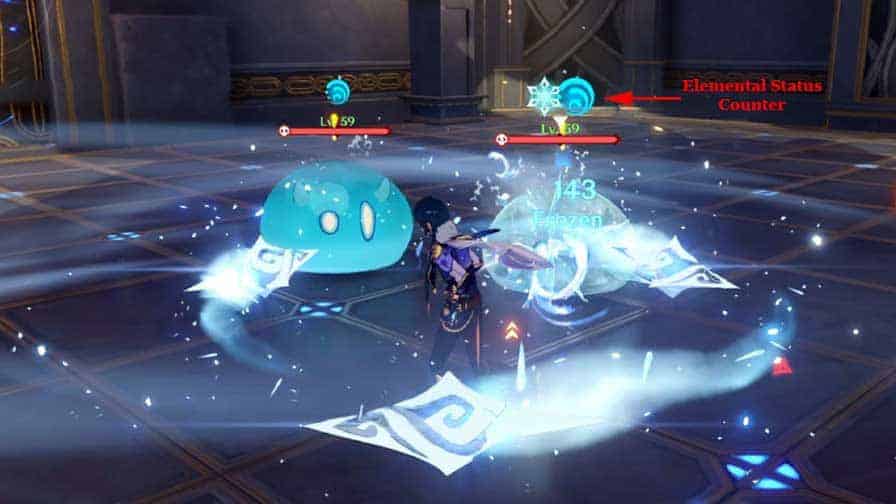
Elemental Status, also known as Elemental Aura, is the icon you see at the top of your enemy’s head whenever you cast a skill.
They are consumed whenever you trigger an elemental reaction.
For example, if you hit an enemy with a Pyro elemental attack, you will see the Pyro icon at the top of the enemy’s head.
At this point, the monster is susceptible to Pyro-related elemental reactions such as Overloaded, Vaporize or Melt.
Once you trigger an elemental reaction, the icons at the top will disappear.
At this point, elemental reactions such as Melt will no longer trigger unless you apply another elemental status to your opponent.
If you want to trigger elemental reactions more effectively, I suggest learning about Internal Cooldowns and the elemental gauge theory.
Damage Ownership
Elemental reaction damage is calculated based on the character who triggered the reaction instead of the one who applied it.
For example, using Fischl’s electro skill on a monster and triggering it with Diluc will calculate the Overloaded reaction damage based on Diluc’s stats.
There is no exception for this, even if the character is on or off the field or no matter what type of reaction is triggered.
Introduction to Internal Cooldowns (ICD)
Internal cooldown is a hidden mechanic in Genshin Impact. It represents an invisible cooldown period determining how often an attack or skill can apply an element or trigger an elemental reaction.
Typically, this cooldown period lasts around 2.5 seconds for most attacks.
Once an attack applies an element, a waiting time of 2.5 seconds is required before you can apply another elemental status to the enemy.
Think of it like a throttle mechanism designed to prevent overly rapid triggering of elemental reactions, ensuring a balanced gameplay experience.
However, it’s worth noting that there are a few techniques to work around ICD, offering opportunities for strategic gameplay.
Elemental Reaction Categories
Elemental reactions can be grouped into three main categories:
- Multiplicative
- Additive
- Transformative
Each category explains the calculation of damage and the underlying mechanics that manifest their effects on monsters or the surrounding environment.
Here’s a quick overview of all elemental reaction and their corresponding categories:
| Category | Elemental Reactions | Damage Scaling |
|---|---|---|
| Multiplicative | Melt Vaporize | Character Level Elemental Mastery Attack Stat Damage Percentage Stat Critical Chance Stat Critical Damage Stat Talent Level |
| Additive | Aggravate Spread | Character Level Elemental Mastery Specific Talent Levels Specific Artifacts |
| Transformative | Overload Electro-Charged Superconduct Freeze Shatter Swirl Crystallize Burning Bloom Hyperbloom Burgeon Quicken | Character Level Elemental Mastery |
Multiplicative Elemental Reactions
Multiplicative elemental reactions significantly amplify the damage output of the character who triggers it.
The character’s overall stats and the sequence of elemental status application influence these reactions.
When triggering elemental reactions under this category, several stats come into play:
- Character Level
- Elemental Mastery
- Attack Stat
- Damage Percentage Stat
- Critical Chance Stat
- Critical Damage Stat
- Talent Level
The way the damage is calculated is pretty straightforward.
It multiplies the damage inflicted by the character who triggered the reaction and multiplies them by 1.5x or 2x.
It will then be further amplified based on the Elemental Mastery of the character.
Multiplicative reactions are also sequence-specific.
The damage multiplier can vary depending on the order in which the reactions are triggered.
Let’s take a look at the elemental reactions that fall under this category:
Melt
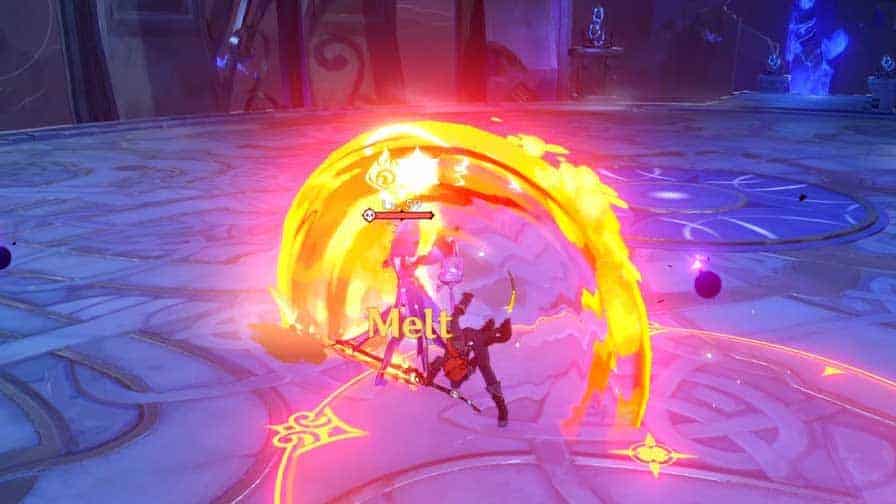
Melt occurs when you hit Cryo with a Pyro element or vice versa.
It will multiply your current elemental attack damage depending on the sequence of elemental status.
Being a multiplicative type of elemental reaction, the overall stats of the character who triggers this reaction are important for the final damage calculation.
If the critical rate triggers during activation, this reaction will also multiply it.
Applying a Cryo skill on a monster with a Pyro status will multiply your Cryo damage by 1.5 times.
Inversely, if you apply a Pyro skill on a monster with a Cryo status, your attack will be multiplied by 2 times.
While 2x damage is great, doing 1.5x will yield higher DPS during long fights.
The concept for this is the Forward and Reverse reactions, which we’ll discuss in a bit.
The pros of this reaction are that it can theoretically yield more significant damage to enemies, per instance.
However, if the character triggering this reaction is a support, it might affect the final damage if your support character has lower offensive stats.
Vaporize
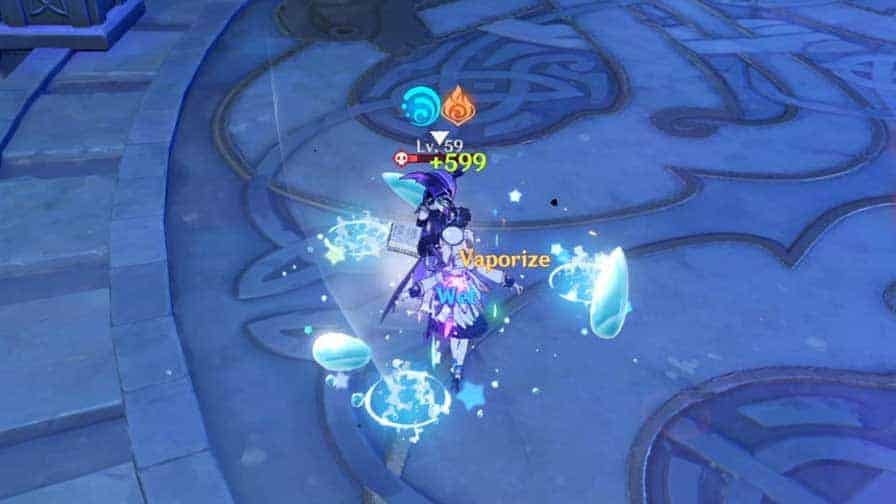
Vaporize occurs when you hit Hydro with a Pyro elemental skill or vice versa.
Same as Melt, this will multiply your elemental attack damage depending on the sequence of elemental status.
Applying a Pyro elemental skill on a monster with a Hydro elemental status will multiply your Pyro damage by 1.5 times.
On the other hand, if you apply a Hydro to Pyro, your attack will be multiplied by 2.
The damage is also based on the character’s overall stats, who triggered this elemental reaction.
And it also has the same pros and cons as Melt.
Forward vs Reverse Reactions
Forward reactions refer to stronger multipliers, and reverse reactions refer to weaker ones.
While forward reactions look better for your damage, both have pros and cons.
Forward reactions produce greater damage in a single hit, but they will also consume the initial elemental status from your enemies.
This means you can only trigger the reaction once (most of the time) for every elemental status application.
On the other hand, Reverse Reactions will preserve some of the elemental status from your enemies, allowing you to proc the elemental reaction more than once.
Here’s a table to help you better visualize what I mean:
| Elemental Reaction | Trigger Sequence | Sequence Type | Pros and Cons |
|---|---|---|---|
| Melt | Cryo + Pyro | Forward Reaction | Higher damage but less frequency of triggering |
| Pyro + Cryo | Reverse Reaction | Lesser damage but a higher frequency of triggering | |
| Vaporize | Pyro + Hydro | Forward Reaction | Higher damage but less frequency of triggering |
| Hydro + Pyro | Reverse Reaction | Lesser damage but higher frequency of triggering |
Transformative Reactions
Transformative reactions add an Elemental Reaction Damage separate from the skill’s damage.
Reaction damage is calculated based on the following:
- Character Level
- Elemental Mastery
The damage dealt by elemental reactions under this category does not do Crit Hit but typically gains higher damage scaling from Character Level and Elemental Mastery than other categories.
Additionally, transformative reactions ignore defense but are affected by elemental resistance.
Let’s take a look at the elemental reactions under this category:
Overloaded
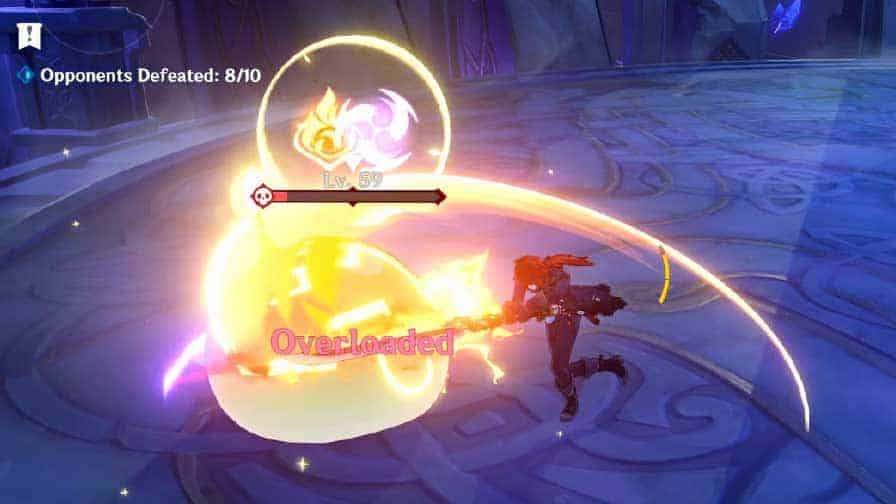
The Overloaded elemental reaction occurs when you hit Pyro with an Electro element or vice versa.
It creates an additional AoE Pyro damage on top of the actual Electro or Pyro damage you inflicted.
It also knocks back small enemies such as slimes or Hilichurls.
Overload damage ignores the target’s defense, level or defensive buffs.
Electro-Charged
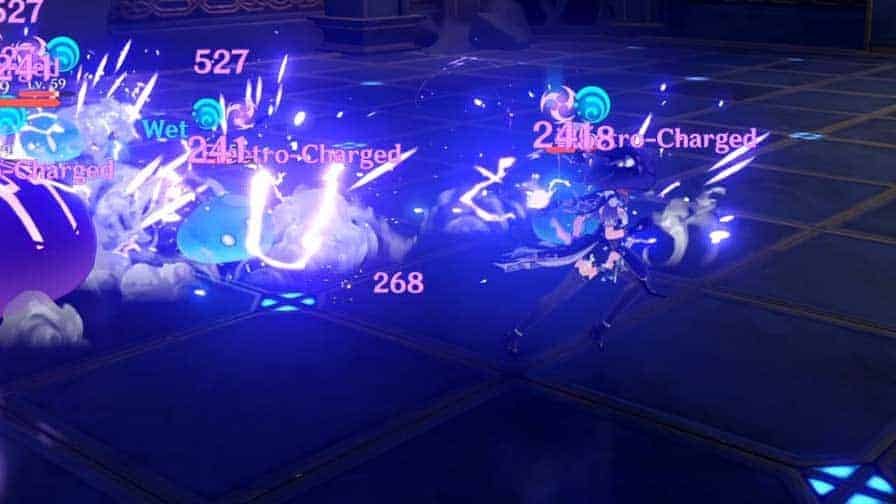
Electro-Charged occurs when you hit Hydro with an Electro element or vice versa.
Enemies affected by this reaction will receive continuous Electro damage until the elemental status wears off.
It has a 1.2x damage multiplier and will also spread to any nearby enemy with a Hydro status.
What’s unique about this reaction is that both Electro and Hydro status can coexist simultaneously during its durations.
This means you can use a third element to trigger a different elemental reaction even when Electro-Charged is active.
Superconduct
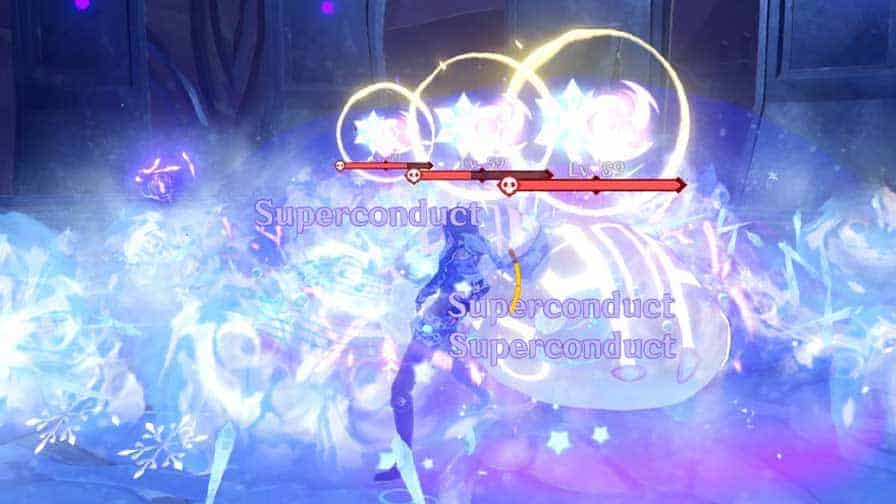
Superconduct occurs when you hit Cryo with an Electro element or vice versa.
It creates an additional Physical AoE Damage from the epicenter of the superconductor on top of the elemental damage.
Furthermore, all enemies hit by its AoE will get a 40% Physical Resistance reduction debuff for 9 seconds.
It ignores the target’s level, defense or defensive buffs.
As part of the transformative elemental reaction, you can scale its damage by leveling your character or increasing the elemental mastery.
However, the debuff’s effect will remain unchanged regardless of the caster’s level or elemental mastery.
Also, the debuff can decrease the enemy’s physical resistance to a negative number.
But its effectiveness is halved once the physical resistance threshold goes below 0.
For example, triggering superconduct to a monster with a 20% Physical Resistance will reduce its physical resistance to -10%.
The way it works is like this:
First, it will reduce the monster’s resistance to 0.
At this point, you still have 20% of the 40% debuff.
But since its effectiveness is halved once it crosses the 0% physical resistance threshold, it will reduce the resistance by 10% more instead of 20.
Frozen
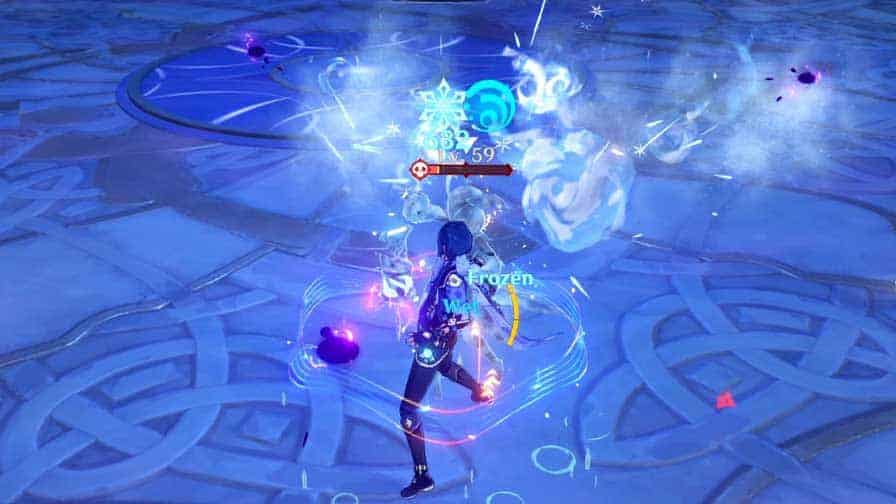
The Frozen elemental reaction occurs when you hit Hydro with a Cryo element and vice versa.
As the name suggests, it freezes the enemy rendering them immobile.
It does not apply additional damage but is an excellent crowd-control effect when dealing with multiple enemies.
Freeze duration does not increase with levels or elemental mastery.
Instead, its duration is based solely on the given elemental gauge unique to each skill.
Frozen enemies can be afflicted with the Shatter elemental reaction.
One thing to note is that the Frozen status does not prevent Boss monsters from moving.
It does, however, still enable the triggering of Shatter.
Shatter
Shatter can only trigger enemies affiliated with the Frozen elemental reaction.
When you hit the Frozen enemy using heavy attacks from Claymores or Geo skills, it will trigger “Shattered” damage.
This reaction will add physical damage on top of your actual damage.
However, Shatter is not dependent on your physical attack stat.
Instead, it depends on your character’s level and elemental mastery stat.
It ignores the enemy’s level, defense and buffs.
Swirl
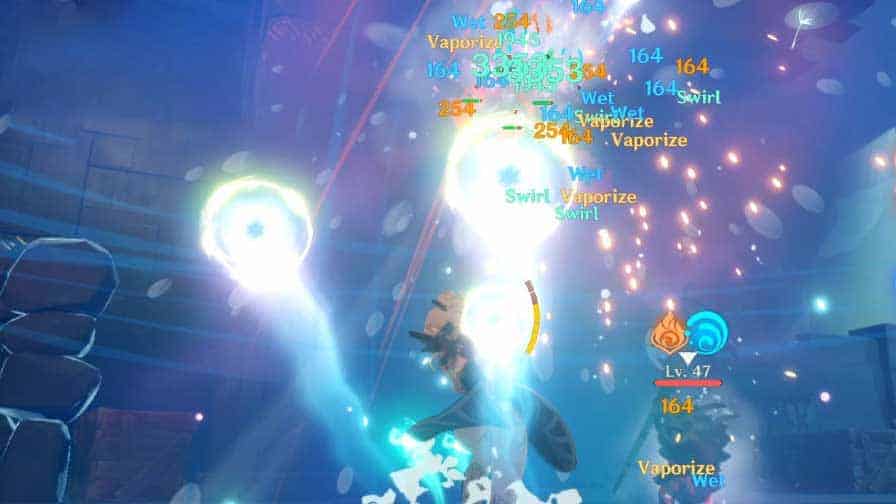
Swirl occurs when you hit an enemy with either a Pyro, Hydro, Cryo, or Electro elemental status with an Anemo elemental skill.
It adds swirl damage on top of your current elemental damage.
It ignores the target’s level, defense, or buffs and has a damage multiplier of 0.6x.
This damage is affected by the caster’s level and elemental mastery only.
Although this damage seems low, it works a little differently from the other elemental reactions.
The Swirl elemental reaction takes any existing element or elements it comes in contact with and spreads it across as damage within a small AoE.
So on top of the Swirl damage, it will also deal elemental damage of the same element it absorbed while triggering other forms of elemental reactions when applicable.
Note: Anemo element cannot put an elemental status on enemies.
There should be an existing elemental status before you can trigger Swirl.
Swirl works best with characters equipped with Virisdescent Venerer for additional elemental resistance shred for every element it absorbs.
Crystallize
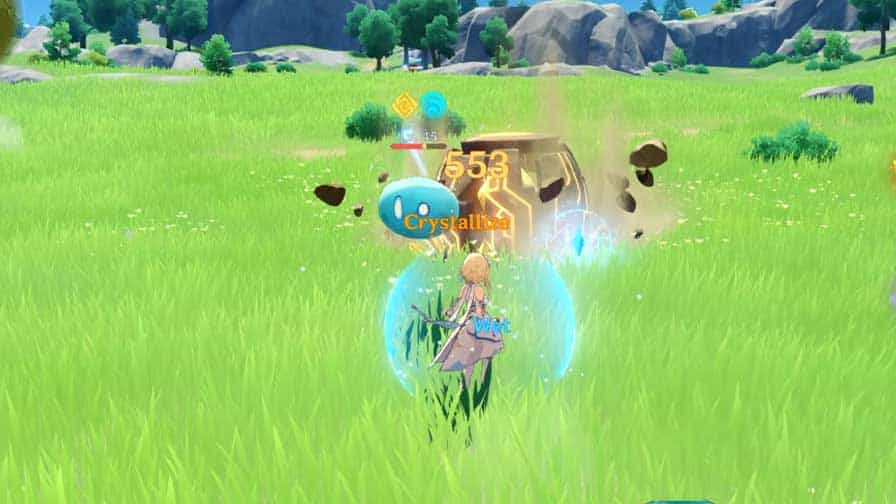
The Crystallize reaction triggers when either Pyro, Hydro, Cryo or Electro elements come in contact with the Geo element.
It works like Anemo, except that it focuses on defense.
When you trigger this reaction, the monsters will drop an elemental crystal that matches the current elemental status of the monster.
Once you obtain this orb, it will create an elemental shield that absorbs all incoming damage.
The shield will be more effective against the matching element (e.g., Pyro attack vs Pyro Shield) of the monsters attacking you.
The shield’s strength is based on your character’s elemental mastery and level.
Geo elements also cannot apply elemental status without an existing one.
So there should be an existing elemental status on the monsters before you can trigger this elemental reaction.
This elemental reaction works best with the Geo Elemental Resonance enabled or paired with the Archaic Petra artifact.
Burning
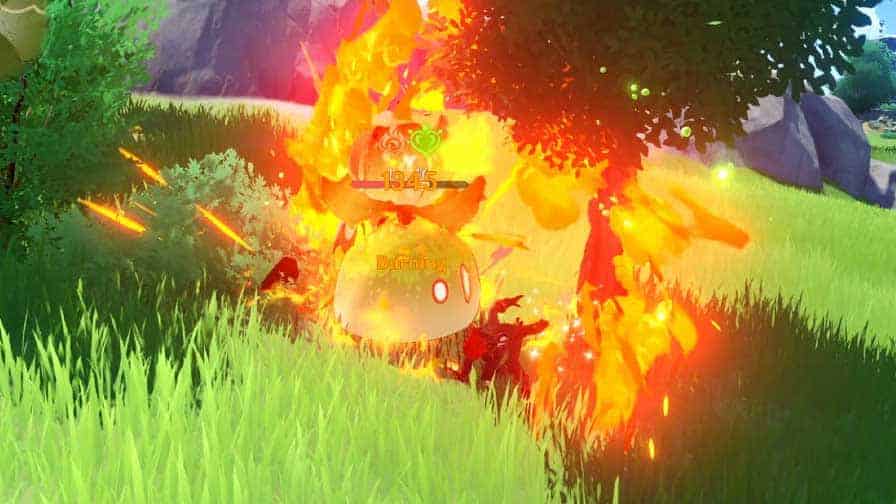
The burning elemental reaction triggers when you apply Pyro to Dendro or vice versa.
Like electro-charged, burning applies Pyro damage over time until the elemental status disappears.
It has a damage multiplier of 0.25x per second and ticks every 0.25 seconds.
While the burning elemental reaction is active, you can cast different elements to trigger other Pyro-related reactions.
A lot of object-specific elemental reactions are also related to Burning.
Objects such as grass or shields from some hilichurls are considered Dendro elements.
Therefore, you can set them ablaze if you apply a Pyro element.
And if you play long enough, you will also encounter some Hilichurl mages that cast a wall of vines in the surrounding area.
You can also remove it by casting Pyro elemental skills.
Bloom
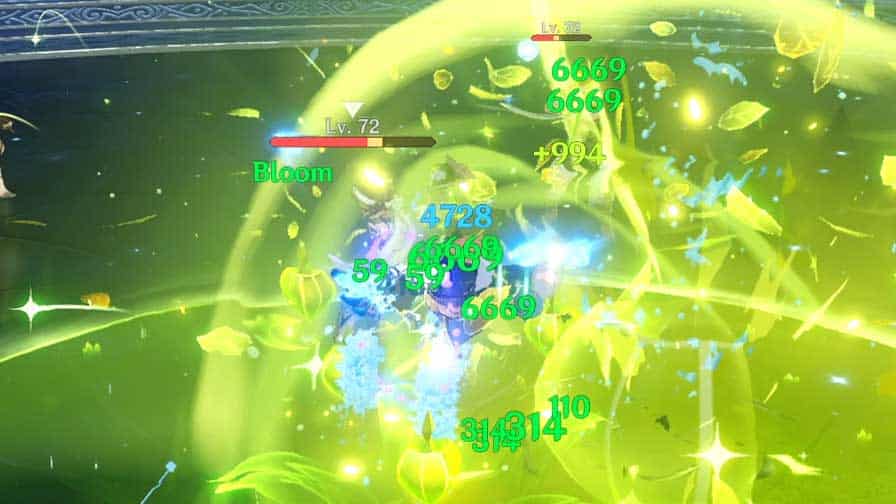
Bloom triggers when you apply Hydro to a Dendro element.
The bloom reaction itself does not initially cause damage to monsters.
Instead, It will create Dendro cores that you can use later to trigger other Dendro-related reactions such as Hyperbloom or Burgeon.
Dendro cores automatically explode after a few seconds, dealing Dendro damage within a 5m AoE radius.
This AoE has a 2x damage multiplier.
Core generation also has a limit of 5. And once you exceed this threshold, the oldest core will explode.
It is important to note that Bloom damage affects players as well.
It applies 5% of the damage inflicted on enemies, regardless of which party member triggers the reaction.
Hyperbloom
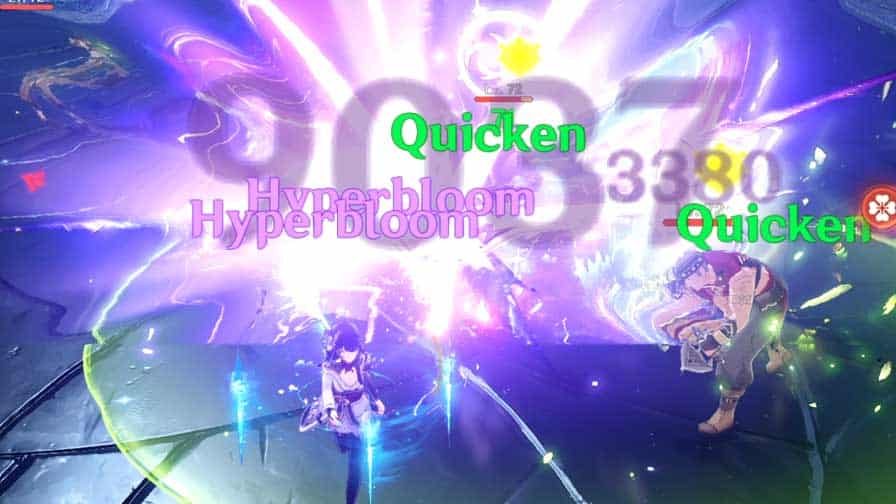
Hyperbloom occurs when you apply the Electro element to a Dendro core generated by the Bloom elemental reaction.
It clears the Dendro core and creates a homing missile that deals Dendro damage to its target.
It has a 3x multiplier and has a very small AoE once it lands on a target.
Note that these missiles can damage your character if it’s within its AoE.
But just like Bloom, players only take 5% of the damage inflicted on enemies.
Burgeon
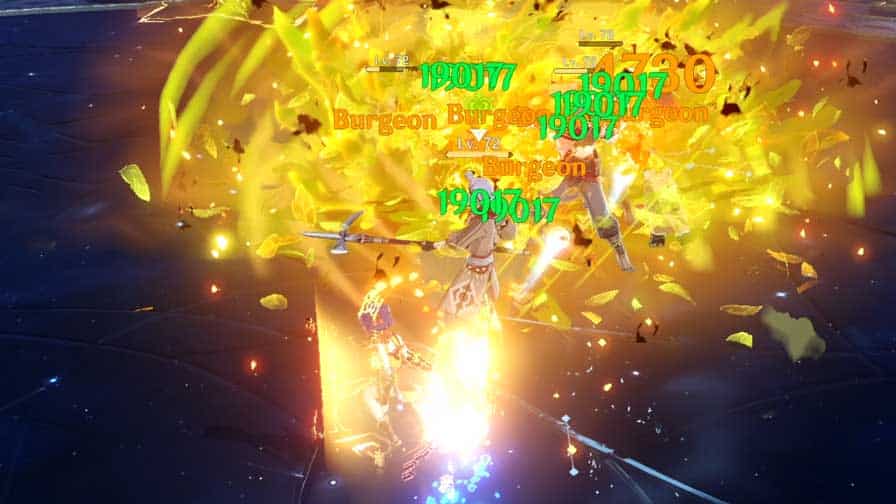
The Burgeon elemental reaction triggers when you apply the Pyro element to a Dendro core generated by Bloom.
Like Hyperbloom, it clears the Dendro core from the field and deals Dendro Damage once triggered.
It has a 3x multiplier and an AoE radius of 5m, similar to Bloom.
And just like Bloom or Hyperbloom, players can take 5% of the damage they inflicted if they get hit within its AoE.
Quicken
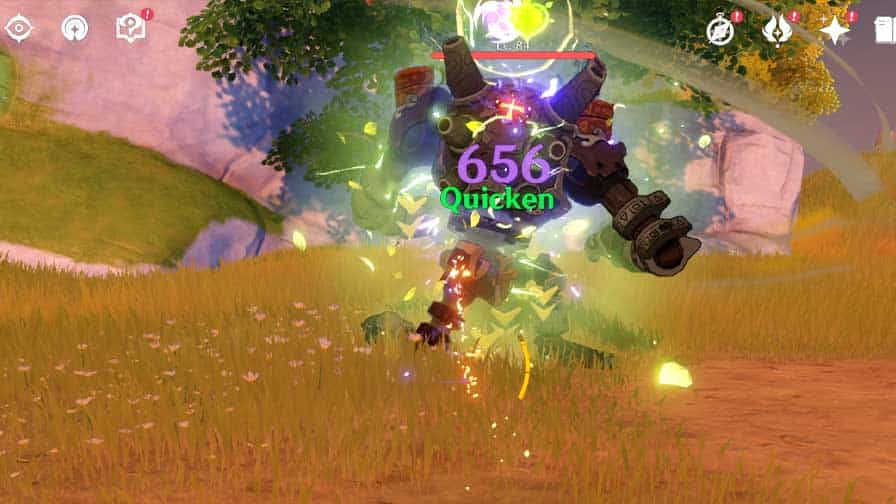
Quicken occurs when you hit Dendro with Electro or vice versa.
This elemental reaction does not cause any damage but allows you to trigger the Aggravate or Spread elemental reaction.
Quicken lasts 7 seconds, and its duration can be refreshed by reapplying Dendro or Electro before expiration.
Additive Elemental Reactions
Additive elemental reactions add a flat damage bonus to the character who triggered the reaction.
Similar to Multiplicative reactions, the triggering character’s attack, critical chance, critical damage, and damage percentage bonus play a role in the final damage calculation.
The main difference is how it gets applied in the final damage calculation.
The way it works is that base damage gets applied to the damage calculation before the calculations of critical damage (in case of critical chance), damage bonus, defense, and elemental resistance take into effect.
The damage can be scaled with the following:
- Character Level
- Elemental Mastery
- Specific Talent Levels
- Specific Artifacts
Character level plays a huge role in boosting its base damage.
And while elemental mastery can also boost the damage of Additive Reactions, it would be detrimental to increase this stat if your main DPS is the one who is constantly triggering this type of elemental reaction.
Instead, opt to use artifacts such as the Thundering Fury.
It can significantly boost the reaction damage without sacrificing attack and damage stats for your main DPS.
Lastly, specific skills such as Baizhu’s 4th Ascension Passive talent can further increase the base damage of Additive Reactions.
Now, let’s take a look at the elemental reactions that fall under this category:
Spread
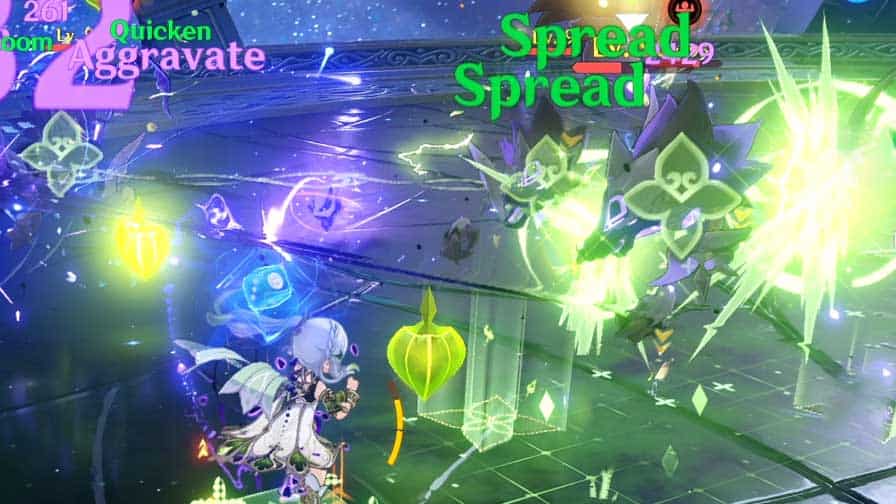
Spread only occurs when you hit a monster affected by the Quicken elemental reaction with a Dendro element. It adds 1.25x Flat Damage to the character who triggered the reaction.
As an additive reaction, it considers the critical damage calculation, albeit indirectly.
Aggravate
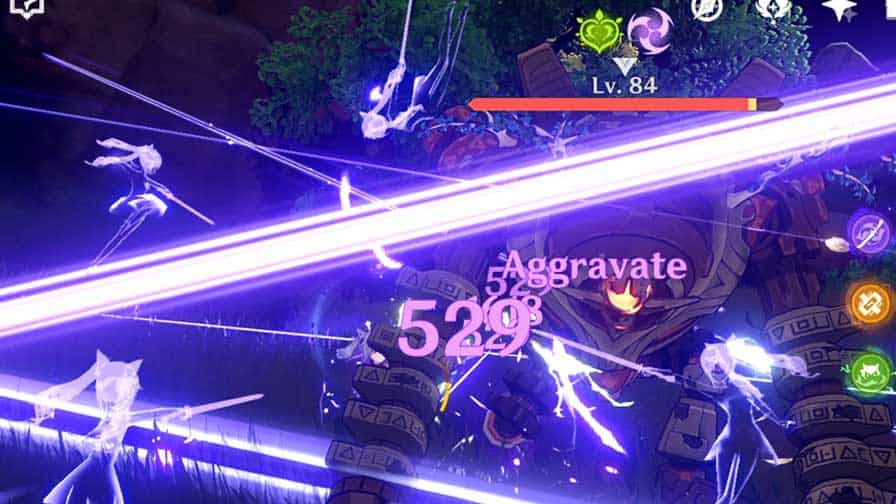
Aggravate is triggered by using the electro element on enemies affected by the Quicken elemental reaction. It adds a 1.15x flat damage to the character who proc the reaction.
Like Spread, it also takes into account the critical damage calculation indirectly.
Additional Elemental Reaction Mechanics
Elemental Monsters
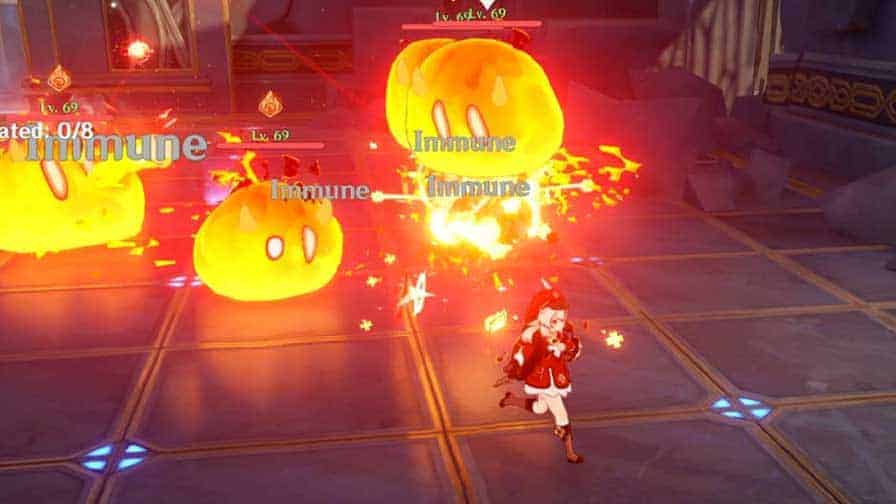
Elemental monsters are specific types of enemies that possess innate elemental attributes and abilities.
They will take no damage when hit with the same innate element.
But casting an elemental skill different from their innate element will immediately trigger an elemental reaction.
For example, if you hit a Cryo slime with a Cryo skill, you will do no damage and see an “Immune” notification instead.
But if you hit them with a Pyro skill, you will immediately trigger the melt reaction.
Most monsters with an innate element are variations of the slime monsters, regisvines and some elite bosses.
They are pretty easy to spot once you play the game.
But if you’re unsure, you can always check the elemental status icon at the top of their heads.
Elemental Shield and Armors
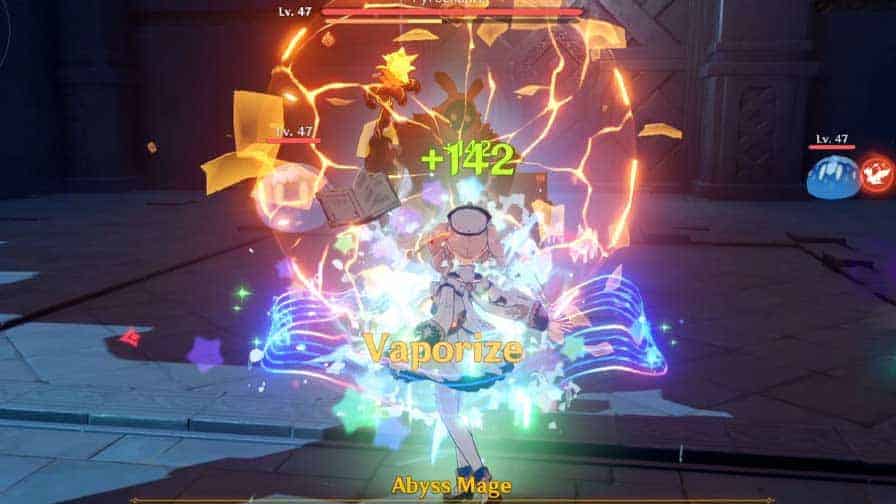
Some monsters with no innate element can cast an elemental shield or armor around them.
Elemental shields will block all incoming damage until the shield breaks.
In the case of elemental armor, they will significantly reduce the damage they take until their armor breaks.
And both shields and armors absorb more damage from the same element their shield or armor is made of.
Treat them like you would with elemental monsters and break their armor or shields through elemental reactions.
Automatically Applied Elemental Status
Some in-game weather conditions and environment interactions can automatically apply elemental status to monsters, players and objects.
Additionally, particular objects possess an inherent elemental infusion.
It’s essential to take note of these mechanics as it allows you to bypass the step of elemental statuses application efficiently and directly trigger elemental reactions.
Below is a table highlighting some in-game events and objects that align with what I mentioned.
| Event | Description |
|---|---|
| Rain | Automatically apply the Hydro Status on you and other monsters walking in the rain. |
| Bodies of Water | Automatically apply the Hydro Status to you or monsters standing in a body of water |
| Grass | Similar to grasses, wooden shields and armor are also considered as Dendro Objects. They also gets burned when it comes in contact with Pyro, but the monsters typically put them out at the cost of delaying their movement. |
| Wooden Weapons/Shields | Similar to grasses, wooden shields and armor are also considered as Dendro Objects. They also get burned when it comes in contact with Pyro, but the monsters typically put them out at the cost of delaying their movement. |
Useful References
Elemental Reaction Damage Table
As you can see, there are quite a lot of elemental reactions, and it’s a bit hard to keep track of the damage multiplier associated with each elemental reaction.
So I prepared a little chart that you can use for reference:
| Elemental Reaction | Multiplier |
|---|---|
| Melt | Cryo to Pyro – 1.5x damage multiplier Pyro to Cryo – 2x damage multiplier |
| Vaporize | Hydro to Pyro – 1.5x damage multiplier Pyro to Hydro – 2x damage multiplier |
| Overload | 2x Multiplier |
| Electro-Charged | 1.2x Multiplier Per Hit 3x Multiplier Per Instance |
| Superconduct | 0.5x Multiplier |
| Freeze | N/A |
| Shatter | 1.5x Multiplier |
| Swirl | 0.6x Multiplier |
| Crystallize | N/A |
| Burning | 0.25x Multiplier |
| Bloom | 2x Multiplier |
| Hyperbloom | 3x Multiplier |
| Burgeon | 3x Multipler |
| Quicken | N/A |
| Aggravate | 1.15x Flat Damage |
| Spread | 1.25 Flat Damage |
Elemental Reactions Per Element Type
When building a team comp around your main DPS character, it helps to know the possible elemental reactions you can trigger from their specific element.
So I prepared a little chart for the possible elemental reactions you can trigger for a specific element and the characters currently available for that particular element.
Here it is:
| Element Type | Possible Elemental Reactions | Characters With The Same Element |
|---|---|---|
| Pyro | Vaporize Overloaded Melt Swirl Crystalize Burgeon Burning | Amber Bennett Dehya Diluc Hu Tao Klee Thoma Xiangling Xinyan Yanfei Yoimiya |
| Hydro | Vaporize Electro-Charged Frozen Swirl Crystallized Bloom | Barbara Candace Kamisato Ayato Mona Nilou Sangonomiya Kokomi Tartaglia Xingqiu Yelan |
| Cryo | Frozen Shatter Superconduct Melt Swirl Crystallized | Aloy Chongyun Diona Eula Ganyu Kaeya Kamisato Ayaka Layla Mika Qiqi Rosaria Shenhe |
| Electro | Superconduct Overloaded Electro-Charged Swirl Crystallized Hyperbloom Quicken Spread Aggravate | Beidou Cyno Dori Fischl Keqing Kujou Sara Kuki Shinobu Lisa Raiden Shogun Razor Yae Miko Electro Traveler |
| Anemo | Swirl | Faruzan Jean Kaedehara Kazuha Sayu Shikanoin Heizou Sucrose Venti Wanderer Xiao Anemo Traveler |
| Geo | Crystallized | Albedo Arataki Itto Gorou Ningguang Noelle Yun Jin Zhongli Geo Traveler |
| Dendro | Bloom Hyperbloom Burgeon Quicken Spread | Alhaitham Baizhu Collei Kaveh Kirara Nahida Tighnari Yaoyao Dendro Traveler |

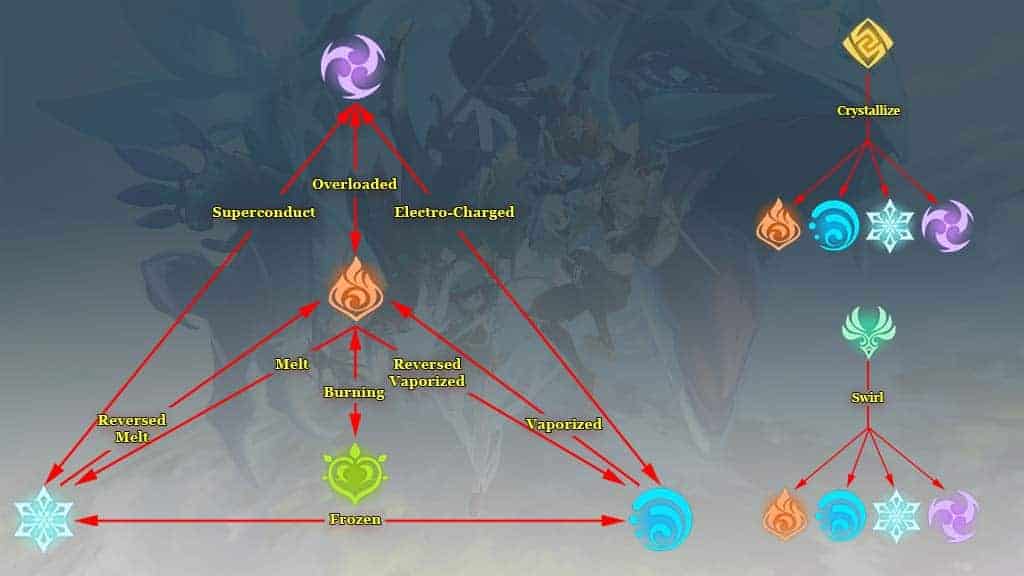










Nice article 😃
Glad you like it!